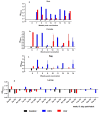Immunization of Nile Tilapia (Oreochromis niloticus) Broodstock with Tilapia Lake Virus (TiLV) Inactivated Vaccines Elicits Protective Antibody and Passive Maternal Antibody Transfer
- PMID: 35214626
- PMCID: PMC8879158
- DOI: 10.3390/vaccines10020167
Immunization of Nile Tilapia (Oreochromis niloticus) Broodstock with Tilapia Lake Virus (TiLV) Inactivated Vaccines Elicits Protective Antibody and Passive Maternal Antibody Transfer
Abstract
Tilapia lake virus (TiLV), a major pathogen of farmed tilapia, is known to be vertically transmitted. Here, we hypothesize that Nile tilapia (Oreochromis niloticus) broodstock immunized with a TiLV inactivated vaccine can mount a protective antibody response and passively transfer maternal antibodies to their fertilized eggs and larvae. To test this hypothesis, three groups of tilapia broodstock, each containing four males and eight females, were immunized with either a heat-killed TiLV vaccine (HKV), a formalin-killed TiLV vaccine (FKV) (both administered at 3.6 × 106 TCID50 per fish), or with L15 medium. Booster vaccination with the same vaccines was given 3 weeks later, and mating took place 1 week thereafter. Broodstock blood sera, fertilized eggs and larvae were collected from 6-14 weeks post-primary vaccination for measurement of TiLV-specific antibody (anti-TiLV IgM) levels. In parallel, passive immunization using sera from the immunized female broodstock was administered to naïve tilapia juveniles to assess if antibodies induced in immunized broodstock were protective. The results showed that anti-TiLV IgM was produced in the majority of both male and female broodstock vaccinated with either the HKV or FKV and that these antibodies could be detected in the fertilized eggs and larvae from vaccinated broodstock. Higher levels of maternal antibody were observed in fertilized eggs from broodstock vaccinated with HKV than those vaccinated with FKV. Low levels of TiLV-IgM were detected in some of the 1-3 day old larvae but were undetectable in 7-14 day old larvae from the vaccinated broodstock, indicating a short persistence of TiLV-IgM in larvae. Moreover, passive immunization proved that antibodies elicited by TiLV vaccination were able to confer 85% to 90% protection against TiLV challenge in naïve juvenile tilapia. In conclusion, immunization of tilapia broodstock with TiLV vaccines could be a potential strategy for the prevention of TiLV in tilapia fertilized eggs and larvae, with HKV appearing to be more promising than FKV for maternal vaccination.
Keywords: antibody; inactivated vaccines; maternal passive immunity; tilapia broodstock.
Conflict of interest statement
The authors declare no conflict of interest.
Figures



Similar articles
-
Tilapia Lake Virus Vaccine Development: A Review on the Recent Advances.Vaccines (Basel). 2023 Jan 23;11(2):251. doi: 10.3390/vaccines11020251. Vaccines (Basel). 2023. PMID: 36851129 Free PMC article. Review.
-
Efficacy of heat-killed and formalin-killed vaccines against Tilapia tilapinevirus in juvenile Nile tilapia (Oreochromis niloticus).J Fish Dis. 2021 Dec;44(12):2097-2109. doi: 10.1111/jfd.13523. Epub 2021 Sep 3. J Fish Dis. 2021. PMID: 34477227 Free PMC article.
-
Evaluation of humoral immunity and maternal antibody transfer in Nile tilapia (Oreochromis niloticus) broodstock following immunization with a bivalent vaccine.Fish Shellfish Immunol. 2025 Oct;165:110545. doi: 10.1016/j.fsi.2025.110545. Epub 2025 Jul 5. Fish Shellfish Immunol. 2025. PMID: 40617412
-
Combining segments 9 and 10 in DNA and recombinant protein vaccines conferred superior protection against tilapia lake virus in hybrid red tilapia (oreochromis sp.) compared to single segment vaccines.Front Immunol. 2022 Jul 25;13:935480. doi: 10.3389/fimmu.2022.935480. eCollection 2022. Front Immunol. 2022. PMID: 35958595 Free PMC article.
-
Immune responses to Tilapia lake virus infection: what we know and what we don't know.Front Immunol. 2023 Aug 9;14:1240094. doi: 10.3389/fimmu.2023.1240094. eCollection 2023. Front Immunol. 2023. PMID: 37622112 Free PMC article. Review.
Cited by
-
Current Challenges of Vaccination in Fish Health Management.Animals (Basel). 2024 Sep 16;14(18):2692. doi: 10.3390/ani14182692. Animals (Basel). 2024. PMID: 39335281 Free PMC article. Review.
-
Tilapia Lake Virus Vaccine Development: A Review on the Recent Advances.Vaccines (Basel). 2023 Jan 23;11(2):251. doi: 10.3390/vaccines11020251. Vaccines (Basel). 2023. PMID: 36851129 Free PMC article. Review.
References
-
- FAO Tilapia Sector Expected to Resume Rapid Growth after Temporary Slowdown in 2020. 2021. [(accessed on 10 December 2021)]. Available online: https://www.fao.org/in-action/globefish/market-reports/resource-detail/e...
-
- Fitzsimmons K. Market Stability: Why Tilapia Supply and Demand have Avoided the Boom and Bust of other Commodities Tilapia; Proceedings of the 4th International Trade and Technical Conference and Position on Tilapia; Kuala Lumpur, Malaysia. 2–4 April 2015; [(accessed on 15 November 2021)]. Available online: https://www.infopesca.org/sites/default/files/complemento/actividadesrec....
-
- Machimbirike V.I., Jansen M.D., Senapin S., Khunrae P., Rattanarojpong T., Dong H.T. Viral infections in tilapines: More than just tilapia lake virus. Aquaculture. 2019;503:508–518. doi: 10.1016/j.aquaculture.2019.01.036. - DOI
-
- Bacharach E., Mishra N., Briese T., Eldar A., Lipkin W.I., Kuhn J.H., Lipkin W.I. ICTV Taxonomic Proposal 2016.016a-dM.A.v2.Tilapinevirus. Create the Unassigned Genus Tilapinevirus. 2016. [(accessed on 27 July 2021)]. Available online: https://talk.ictvonline.org/ICTV/proposals/2016.016a-dM.A.v2.Tilapinevir....
Grants and funding
LinkOut - more resources
Full Text Sources

